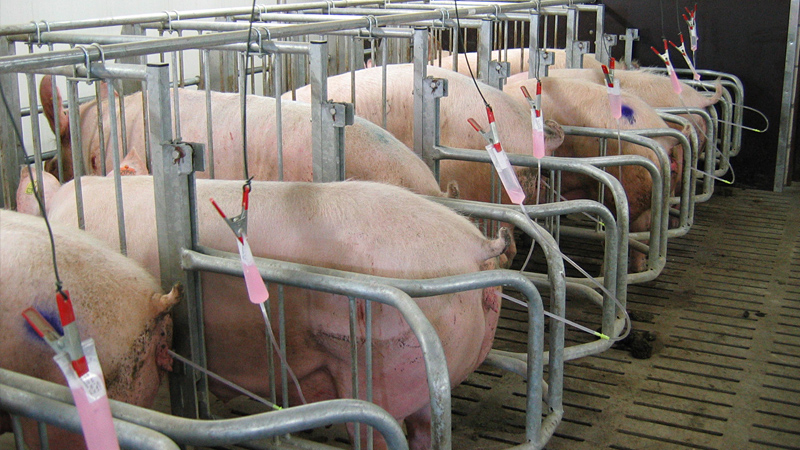- Home
- EU PiG – Male fatteners without boar taint
EU PiG – Male fatteners without boar taint
The risk of boar taint can be reduced to almost zero by selecting particular terminal line boars for artificial insemination. Use of these ‘odour-tested’ sires will help farmers ensure the marketability of pork and avoid monetary deductions for conspicuous odours in boar carcases.
Ambassador: Dr Meike Friedrichs, Germany
Publication date: June 2018
Theme: Meat quality
Challenges: Reducing boar taint
A boar with genetics related to low boar taint was identified by research during the EN-Z-EMA (electronic nose, breeding, entire boar fattening) and Strat-E-Ger (strategic boar choice against taint) study, a project coordinated by the University of Bonn. The boar’s progeny have been intensively tested, so his suitability for use in boar fattening is proven.
Boar taint is determined by the key elements androstenone and skatole. Both of these substances have high heritability, so these traits can be included in a breeding value calculation.
Why select particular terminal line boars for artificial insemination?
- The risk of boar taint for male fatteners is nearly zero if a group of the 25% best odour-tested sires is chosen
- There are only 0.75% odour deviants when carcases are checked for odour in the slaughterhouse, compared to 3.5% in pigs bred without the use of odour-tested sires
- In the long term, producers will be able to avoid monetary deductions for boars with conspicuous odours, which affect the usability of the meat. There will not be any deductions until the ban of castration without anaesthetisation, which comes into effect in Germany in January 2019
- The money saved will outweigh the additional cost of semen from odour-reduced sires. Assuming the slaughtering of 2,250 boars, without the use of odour-tested sires, 79 boars will show boar taint with a loss ranging from €1,580 up to €6,320. Using the odour-tested sires, only 17 boars will present boar taint, and the losses will be limited up to a maximum of €1,360. The extra cost of semen from odour-reduced sires is €990 per 150 sows
- Farmers can stop castration and reduce the linked labour costs
- Finishing traits like daily gain and feed conversion can be improved
How to reduce boar taint
- Strict protocols are in place for storage and temperature control, both before and after semen arrives on the farm
- Suckling piglets spend the first four weeks with their mother and, after weaning, the male and female piglets are typically raised together in a flat deck system
- For the fattening period, the animals are separated according to their sex
- Following slaughter, each boar carcass is checked by an independent certification body for possible odour deviations: a certain area of the adipose tissue in the neck is heated and checked by specially trained, odour-sensitive personnel
- Carcasses with potentially conspicuous odours are separated
- Semen is commercially available for piglet producers across the EU
Case studies
Technical reports
Meat quality best practice challenges
Being competitive in small-scale farming: Developing a niche market for pork
How to promote pork to consumers
Opening farms to engage with public
Replacing GMO in soy for feed production
Homogenous groups of pigs for slaughter
Innovations in the supply chain
Contact us
Contact RPIG (Germany): Wiebke von Seggern or EUPig@ahdb.org.uk
 EU PiG
EU PiG
Reducing boar taint via the breeding programme means that fattening of uncastrated male piglets can work more effectively in practice.
This project has received funding from the European Union`s Horizon 2020 research and innovation programme under grant agreement No 727933.
 Government logo
Government logo

